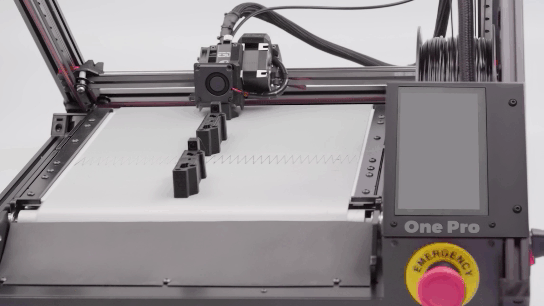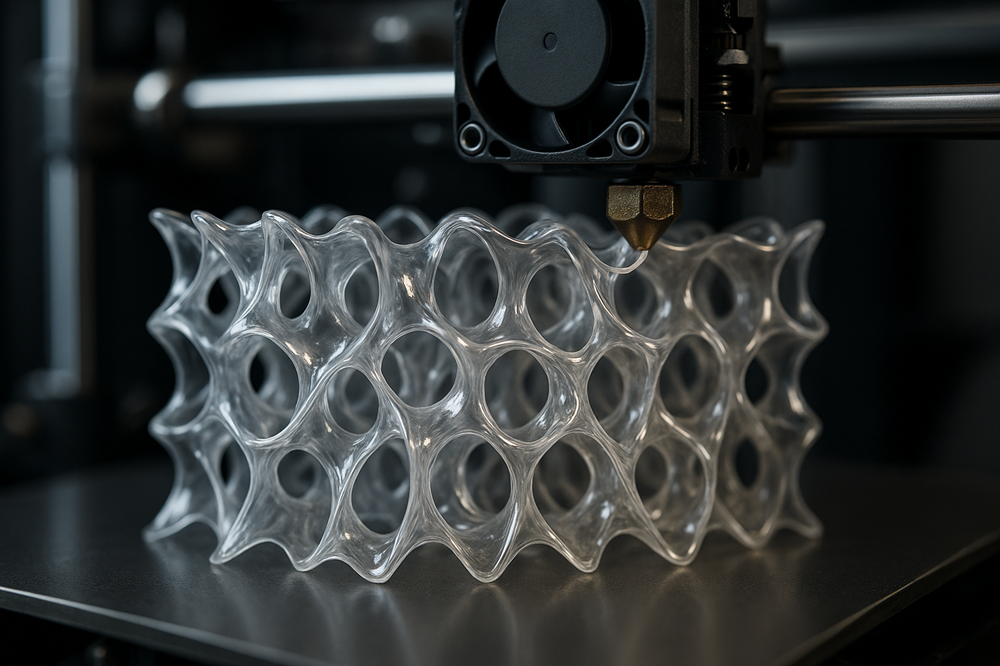Nature has perfected structures over millions of years that offer maximum stability with minimal material expenditure. From the delicate architecture of corals to the efficient honeycomb structure of beehives – everywhere we find examples of optimized geometries. Modern manufacturing technology today harnesses exactly these principles, particularly through the use of TPMS structures in 3D printing. These mathematically defined geometries are revolutionizing the way we think about lightweight construction, stability, and functionality in additive manufacturing.
What are TPMS Structures and Why Are They So Special?
TPMS stands for “Triply Periodic Minimal Surfaces” – triply periodic minimal surfaces. These complex mathematical structures are characterized by their unique property of having the smallest possible surface area for a given volume. Imagine a soap bubble that repeats infinitely in a grid while perfectly merging into each other – this comes very close to the concept.
The fascination of these structures lies in their natural elegance and technical superiority. Unlike conventional lattice structures, which often consist of straight struts, TPMS geometries follow gentle, continuous curves. This organic form leads to more uniform stress distribution and avoids weak points that can occur at connection points in traditional constructions.
Technical Advantages for Additive Manufacturing
3D printing is the only manufacturing technology with the potential to economically produce these highly complex structures. While conventional manufacturing processes would fail with the intricate geometries, modern 3D printers can build these structures layer by layer.
The advantages are diverse: TPMS structures offer an exceptional strength-to-weight ratio. Due to their continuous surfaces, no abrupt transitions or notch effects occur, leading to significantly higher fatigue strength. At the same time, the open-pore structure enables excellent flow properties – a crucial factor for many technical applications.
Another remarkable aspect is the scalability of these structures. The mathematical algorithms that define TPMS can easily be adapted to different scales. From microscopically small structures for filter applications to large-format architectural elements – the principles remain the same while the application possibilities are virtually unlimited.
Practical Applications in Various Industries
The medical technology sector was one of the first industries to discover TPMS structures in 3D printing. Particularly in implantology, these geometries show their strengths. Bone implants with TPMS structure promote the ingrowth of the body’s own tissue, as their porosity resembles natural bone structure. The continuous interconnection of pores enables optimal nutrient supply and promotes osseointegration – the fusion of the implant with the surrounding bone.
In the aerospace industry, TPMS structures are revolutionizing lightweight construction. Components that were previously manufactured from solid material can now be replaced by intelligent TPMS fillings that offer comparable or even better mechanical properties at a fraction of the weight. This leads to significant fuel savings and expanded payload capacities.
The automotive industry increasingly uses TPMS geometries for crash structures and energy absorbers. The uniform deformation of these structures under load makes them ideal for safety components. At the same time, they find application in developing new cooling concepts for electric motors and batteries, where their high surface area with low volume enables optimal heat dissipation.
The Special Role of Conveyor Belt Printing for TPMS Applications
The innovative conveyor belt printing technology from iFactory3D opens up completely new dimensions for the production of TPMS structures. While conventional 3D printers are limited by their restricted build volume, the continuous conveyor belt system enables the production of virtually unlimited long components with TPMS filling.
The 45-degree inclined print head of the iFactory3D system offers a decisive advantage: Complex TPMS geometries can be printed without additional support structures. This is particularly important since the intricate channels and cavities of a TPMS structure would be practically impossible to realize with conventional supports. Removing such supports from the complex internal geometries would be practically impossible.
The possibility of printing hollow components with TPMS core and subsequently filling them with reinforcing materials like PU foam or epoxy resin opens new paths in composite material technology. This creates hybrid structures that combine the advantages of TPMS geometry with the specific properties of various filling materials.
Design Guidelines and Optimization Strategies
The successful implementation of TPMS structures requires a deep understanding of the relationships between geometry, manufacturing process, and desired properties. The choice of specific TPMS types – whether Gyroid, Schwarz-P, or Diamond – depends on the concrete requirements. Gyroid structures, for example, offer isotropic properties and are excellent for applications requiring uniform load-bearing capacity in all directions.
The cell density and wall thickness of the TPMS structure must be carefully matched to the application. Higher cell density leads to better mechanical properties but also increases weight and material consumption. Modern simulation software makes it possible to optimize these parameters for specific load cases and thus find the perfect balance between performance and efficiency.
When designing for conveyor belt printing, the specific design guidelines must additionally be observed. The orientation of the TPMS structure should be chosen so that the continuous surfaces optimally benefit from the 45-degree printing angle. This not only minimizes printing time but also improves surface quality and structural integrity of the component.
Future Perspectives and Development Trends
Research on TPMS structures for 3D printing is still at the beginning of its possibilities. New mathematical models continuously expand the spectrum of available geometries. At the same time, advances in materials science enable the combination of TPMS structures with functional materials, for example for piezoelectric applications or adaptive structures.
The integration of artificial intelligence into the design process promises to elevate the optimization of TPMS structures in 3D printing to a new level. Machine learning algorithms can learn from millions of simulations and suggest the ideal geometry for specific use cases. This will drastically reduce development times while maximizing the performance of the structures.
A particularly exciting research field is the development of graded TPMS structures, where properties change continuously across the component. Areas with high loads could have a denser structure, while less stressed zones save weight through a more open geometry.
Practical Implementation with iFactory3D
The revolutionary conveyor belt printing technology from iFactory3D makes the advantages of TPMS structures accessible for a broad spectrum of industrial applications. The combination of the ability to produce unlimited long components and the possibility of printing complex hollow structures without supports positions this technology ideally for the next generation of lightweight components.
The expertise of iFactory3D in processing various materials opens paths that would be unthinkable with conventional manufacturing methods. From custom filter structures for the process industry to revolutionary architectural components – the possibilities are virtually unlimited.
The future of additive manufacturing lies in the intelligent combination of advanced geometries like TPMS with innovative manufacturing technologies. iFactory3D stands at the forefront of this development and already today offers the tools to realize tomorrow’s visions. Discover how TPMS structures and conveyor belt printing can revolutionize your product development. Contact the expert team at iFactory3D and learn how you can utilize this forward-looking technology for your specific requirements. Together we shape the future of additive manufacturing – more efficient, lighter, and more powerful than ever before.
 Serial production
Serial production
